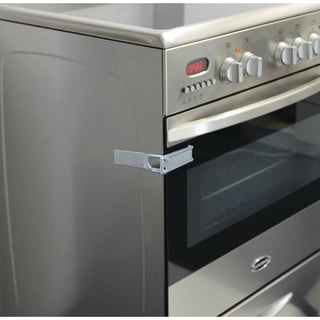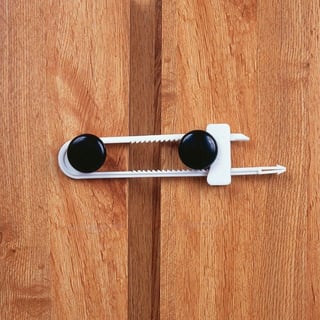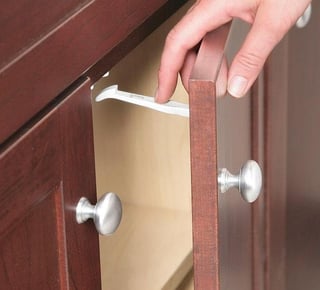Today’s busy families spend an inordinate amount of time in the kitchen. The modern kitchen is the central hub where people gather to talk, read, prepare and eat meals, open mail, use the computer, do homework or just relax after a long day. This is especially true if you’re a foodie dad or mom and you love to cook. As a result, more and more children are spending time in the kitchen as well—something that was almost unheard of a generation ago.
The great thing about kitchen-centric homes is that they allow families to spend more time together. The problem is that kitchens are inherently dangerous places, especially for children. Sharp knives, breakable glassware, hot stoves, chemical cleansers and hard, slippery surfaces are just some of the hazards children face in the kitchen.
Fortunately, with a minimum investment of time and money, you can create a much safer environment for your children. Listed below are 20 ways to improve kitchen safety. However, keep in mind that the very best way to protect a child in the kitchen—or anywhere else—is with diligent adult supervision.
Here are 20 steps for a kid-safe kitchen:
- Whenever possible, cook on the stove’s rear burners which are out of reach for most toddlers. When cooking on the front burners, always turn the pot handles inward.
- To prevent a child from turning on the stove, either remove the knobs or install plastic safety covers.
- When using countertop appliances, such as electric woks, blenders, coffeemakers, and toasters, be sure all power cords are tucked back and not hanging down over the countertop edge.
- Never set a pot, bowl or knife near the edge of the counter where a toddler could reach it.
- It’s imperative that the kitchen range is securely screwed to the wall to prevent it from toppling over and onto a child. All new ranges come with the proper hardware. If you don’t have it, contact the manufacturer.
- Secure to the wall all kitchen bookcases, shelving units, storage racks and other freestanding fixtures.
- Never hold a child in your arms when cooking. Instead, place an infant in a high chair or car seat well away from the stove. For a toddler, set up a playpen in the kitchen but outside of the traffic flow. In the same vein, don’t sit a child on your lap while you drink a hot cup of coffee, tea or soup.
- Remove sharp knives from your drawers and store them in an upper cabinet well out of the reach of children.
- Keep the dishwasher door locked to prevent a child from reaching in and grabbing a knife, glass or dish. Install childproof safety straps on the doors of ovens, refrigerators, trash compactors and other appliances.

Caption: Keep kids from opening major appliances with peel-and-stick door locks.
9. Store all cleansers, pesticides, and detergents in an upper cabinet or high shelf well out of the reach of children. If you must store these materials in a base cabinet, secure the cabinet door with a childproof lock.
10. Insert safety covers into all kitchen electrical outlets, especially those on an island or peninsula.
11. Secure kitchen base cabinets with either adjustable slide locks or safety latches. Slide locks are more secure, but safety latches are easier to operate.

Caption: Easy-to-install and affordable slide locks clasp onto cabinet door knobs or handles.

Caption: To disengage a safety latch, open the cabinet door and press down on the locking tab.
13. If possible, store the kitchen trashcan behind a locked cabinet door. Otherwise, secure the can’s lid with a childproof safety strap.
14. Plastic bags pose a suffocation hazard to small children. Place all plastic bags out of reach in an upper wall cabinet or on a high shelf.
15. If any kitchen window is covered with blinds or shades, keep the pull cord tied up and out of the way to avoid entangling a child.
16. Move pet bowls out of the kitchen to prevent a child from eating and possibly choking on hard, dried food.
17. Keep all alcohol away from children, including common kitchen ingredients such as cooking wines, certain vinegars and lemon, almond, and vanilla extracts.
18. Small magnets pose a choking hazard for children. Remove them from the refrigerator door.
19. If you have an eat-in kitchen, don’t use tablecloths. Kids love to tug on them, which could result in a serious injury from falling utensils or spilled hot food.
20. Remove or secure all kitchen stools to prevent a toddler from either pulling one down onto himself or climbing up and then falling to the floor.
In conclusion, it’s important to remember that children are constantly learning and growing, and your kitchen safeguards must change along with them to maintain the same level of security. If you one day you find that your child has breached your security measures, then it’s time to upgrade to a new, more-age-appropriate safety device to protect your child.
Home improvement expert Joe Truini has worked for many years as a construction carpenter. As a result, Joe has amassed a large amount of information on safety tips for the kitchen, including aspects of safety related to kitchen cabinets. Joe writes for The Home Depot, where you can find many ideas for kitchen cabinets here.




